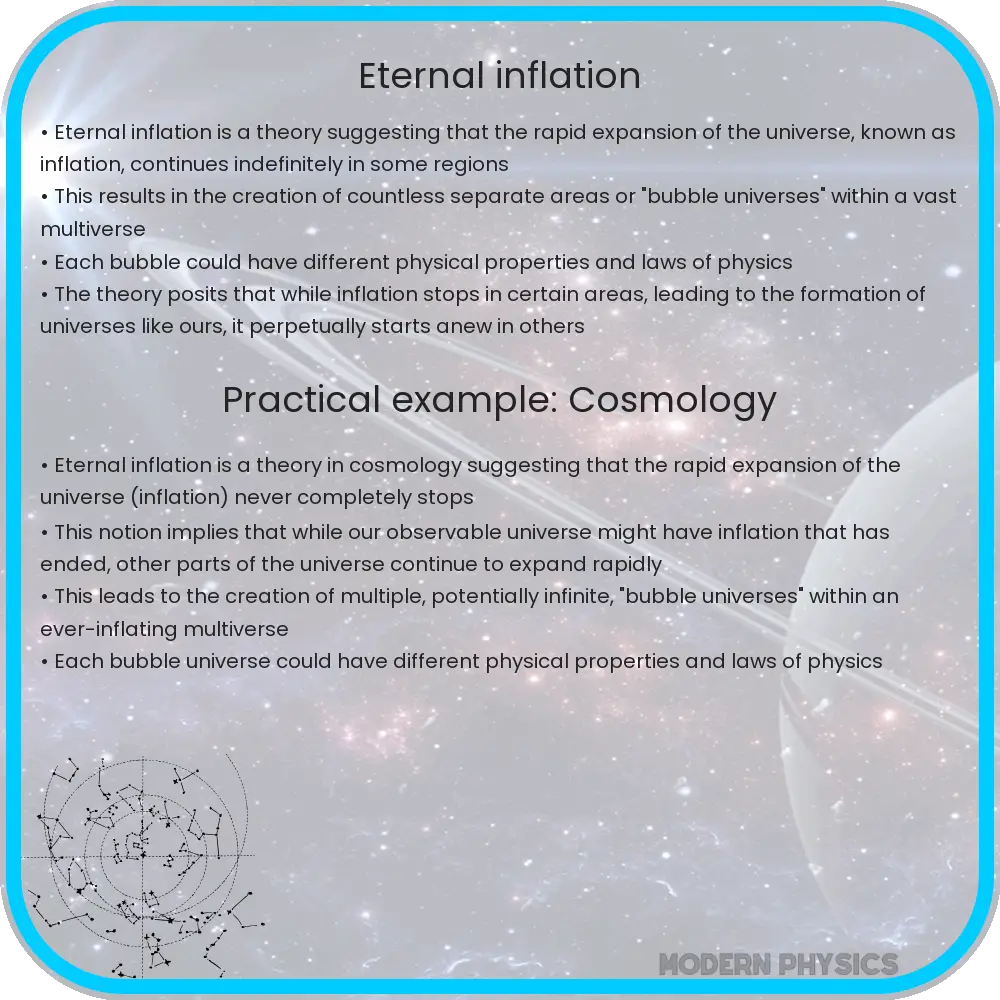Explore the concept of eternal inflation in cosmology, uncovering the universe’s endless expansion, implications for the multiverse, and the role of quantum fluctuations.

Eternal Inflation: Unraveling the Universe’s Endless Expansion
In the vast, ever-expanding cosmos, the concept of eternal inflation stands out as a profound theory, offering insights into the early universe and the nature of cosmic evolution. Stemming from the idea of inflationary cosmology, eternal inflation suggests that the universe has been undergoing an endless expansion since the Big Bang. This continuous growth is not uniform but occurs in a patchwork manner, with different regions expanding at varying rates.
The Basics of Inflationary Theory
Inflationary theory, proposed by physicist Alan Guth in the early 1980s, posits that just after the Big Bang, the universe experienced an exponential expansion. This rapid growth smoothed out any irregularities and homogenized the observable universe. However, the groundbreaking aspect of eternal inflation is that it extends this concept indefinitely. It proposes that even as our observable universe has stopped inflating, other regions beyond our cosmic horizon continue to expand, giving rise to a multiverse scenario.
Implications of Eternal Inflation
Eternal inflation carries significant implications for cosmology and our understanding of the universe. It suggests that the cosmos is far larger and more diverse than previously imagined. In this scenario, different pockets of the universe could exhibit varying physical constants and laws of physics, potentially hosting diverse forms of life and civilizations. Additionally, the theory addresses some of the central puzzles in cosmology, such as the flatness problem and the horizon problem, by explaining how different regions of the universe can evolve independently.
Challenges and Observational Evidence
While the concept of eternal inflation is compelling, it is not without its challenges. One of the main issues is the lack of direct observational evidence, as regions undergoing eternal inflation lie beyond our observable universe. However, indirect evidence, such as the uniformity and flatness of the observable cosmos, supports the broader inflationary model. Scientists continue to explore this theory through cosmological observations, such as the cosmic microwave background radiation and the distribution of large-scale cosmic structures.
Exploring the Multiverse and Quantum Effects
The idea of eternal inflation naturally leads to the concept of a multiverse — an endless collection of bubble universes each possessing different physical properties. Within this framework, our universe is just one of countless others, each with its own set of physical laws and constants. This notion challenges the very definition of ‘universe’ and pushes the boundaries of scientific understanding into the realms of philosophy and metaphysics.
Quantum Fluctuations and Eternal Inflation
At the heart of eternal inflation are quantum fluctuations, random changes in energy levels that can cause new universes to spring from the fabric of the existing one. These fluctuations can lead to the creation of regions where inflation never stops, perpetuating the cycle of universe creation. The quantum nature of these events means that the process is unpredictable and varied, leading to a rich tapestry of possible universes within the multiverse.
Future Directions in Cosmological Research
The study of eternal inflation and its implications is at the forefront of cosmological research. Advances in technology and observational techniques may one day provide clearer evidence of other universes or reveal further insights into the nature of our own. Researchers are also delving into the mathematical underpinnings of the theory, seeking to understand the conditions necessary for eternal inflation and the characteristics of the resulting universes.
Conclusion
Eternal inflation presents a fascinating, albeit speculative, panorama of a cosmos that is far more complex and varied than we could have imagined. It challenges our perceptions, suggesting that what we see is but a tiny fragment of a much larger and more diverse cosmic landscape. While direct evidence for eternal inflation remains elusive, the theory provides a compelling framework for understanding the origins and structure of the universe. As our tools and theories evolve, so too will our understanding of the cosmos, potentially uncovering new truths about the fabric of reality and our place within it.
